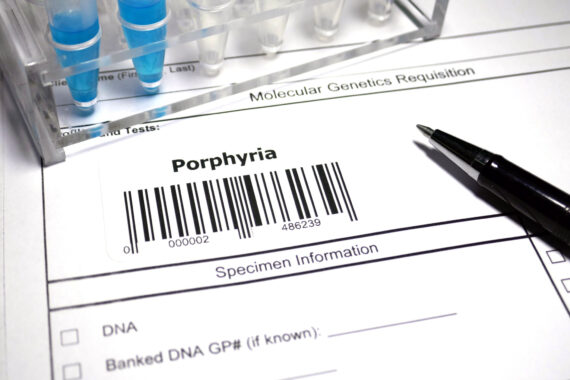Dr Penelope Stein, consultant haemotologist, and Dr Danja Schulenburg-Brand, consultant in chemical pathology, introduce this rarely-seen condition
What is porphyria?
The porphyrias are a group of rare disorders of haem synthesis, which are mostly inherited. They present with attacks of severe abdominal pain (acute porphyria) or light-sensitive skin problems (cutaneous porphyria). There is some overlap between the two types.
Acute porphyria
This group includes acute intermittent porphyria, variegate porphyria (VP) and hereditary coproporphyria. Most people who inherit an acute porphyria never have any symptoms, and only 1% have acute attacks. Attacks typically affect young women and may be triggered by the normal hormonal fluctuation of the menstrual cycle, certain medications, alcohol, calorie restriction or stress. Clinical features are non-specific so the diagnosis is easily missed.
The main symptom in a porphyria attack is severe, poorly-localised pain in the abdomen, back and legs, often with nausea, vomiting, constipation, fatigue and mild psychiatric features such as agitation and insomnia. Urine may appear red or orange especially after light exposure. Pulse and blood pressure are usually raised and hyponatraemia is a common finding, but examination and routine blood tests may be normal especially in an early attack.
Delays in treating an attack can result in life threatening complications. Severe attacks of acute porphyria may be complicated by seizures, severe hyponatraemia, progressive motor neuropathy leading to paralysis and respiratory failure, or overt psychosis.
Cutaneous porphyria
There are two phenotypes. Porphyria cutanea tarda (PCT) and VP cause clinically identical cutaneous features in adults with blisters, skin fragility, erosions and milia in areas exposed to sunlight, such as the backs of the hands and face. PCT usually presents in middle age, in association with excess alcohol, liver iron overload or Hepatitis C infection. VP presents in younger patients without these risk factors.
Erythropoietic protoporphyria (EPP) presents in childhood with acute painful photosensitivity, usually within minutes of sun exposure. Prolonged exposure leads to redness and swelling and the pain may last for days. Affected individuals typically avoid the sun so examination is often normal which delays diagnosis.
How rare is it?
The prevalence of symptomatic acute porphyria is about 1 in 150,000 people but as many as 1 in 2,000 people carry a genetic variant. PCT is the most common cutaneous porphyria, occurring in 1 in 25,000 people. The other cutaneous porphyrias are much rarer.
May be confused with:
An acute porphyria attack may mimic other medical and surgical abdominal emergencies. Patients complaining of pain without an obvious cause may be incorrectly diagnosed with mental health problems or labelled as opiate seeking.
EPP may be confused with solar urticaria. Other bullous dermatoses that should be considered are pseudoporphyria, bullous pemphigoid, pemphigus, phytophotodermatitis, epidermolysis bullosa and dermatitis herpetiformis.
Clues for early detection
Consider the possibility of acute porphyria in a young woman with recurrent undiagnosed abdominal pain, especially when pain is associated with hyponatraemia, psychiatric or neurological features. The first line test is a urine porphobilinogen measurement on a random urine sample collected in a plain (white top) tube.
Blisters and fragility in sun exposed areas only, or a history of acute painful photosensitivity in response to visible light exposure should prompt exclusion of a cutaneous porphyria. This can be done by requesting plasma porphyrin analysis on an EDTA blood sample.
All samples for porphyria testing must be protected from light by placing in a brown envelope after collection. They can be sent to your local laboratory as usual.
Treatment and prognosis
Patients with possible acute porphyria should be referred to a specialist porphyria service to confirm the diagnosis and provide management advice, including information about factors that may trigger attacks such as drugs. There is a list of UK porphyria specialist centres on the website of the British Porphyria Association, which also has useful information about the condition.
Patients with acute attacks usually require admission to hospital and may require infusions of haem arginate. A new gene silencing preventative drug (givosiran) works well in patients with recurrent attacks.
It is rare for patients to die from a porphyria attack now that effective treatments are available. Late complications of acute porphyria include an increased risk of chronic kidney disease, hypertension and hepatocellular carcinoma.
Cutaneous porphyria should be managed in centres with porphyria experience. The cornerstone of treatment is light avoidance through covering up and special sunscreens which block visible (not UV) light. Specific treatment modalities differ depending on the type of cutaneous porphyria. Although impacting significantly on quality of life, the prognosis in EPP and PCT is generally good.
The National Acute Porphyria Service offers 24/7 urgent advice (phone 02920 747747) on acute porphyria.
Dr Penelope Stein is consultant in haematological medicine (porphyria) at King’s College Hospital, London. Dr Danja Schulenburg-Brand is consultant in chemical pathology and lead of Cardiff porphyria service, University Hospital of Wales
Editor’s note: We changed the final sentence on 17 May at 14:40 from ‘The prognosis in EPP and PCT is generally good, although treatment can impact on quality of life’ to ‘Although impacting significantly on quality of life, the prognosis in EPP and PCT is generally good.’ Please accept our apologies
Pulse October survey
Take our July 2025 survey to potentially win £1.000 worth of tokens













